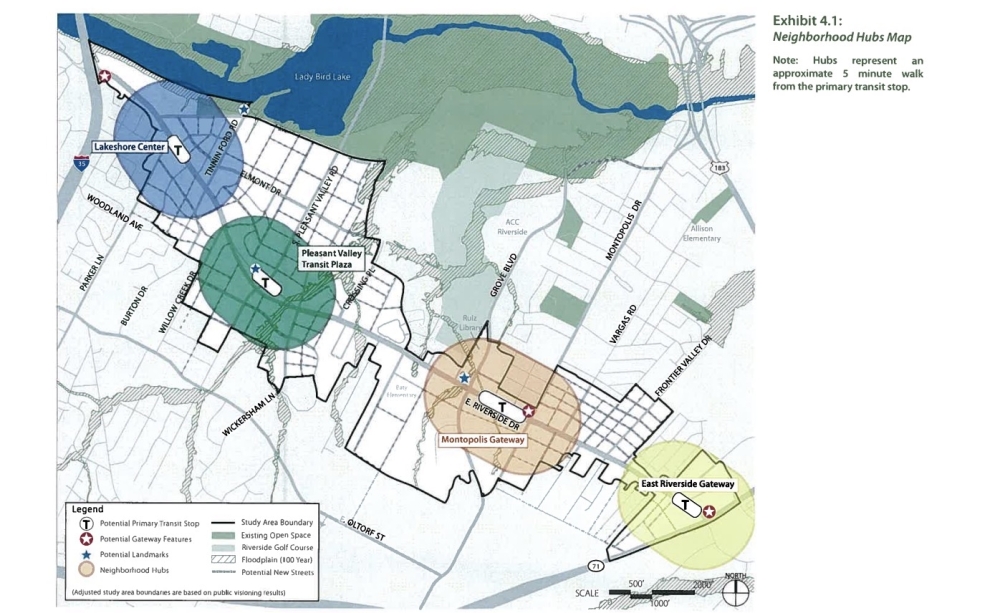The setup
On Aug. 8, the Austin Planning Commission approved zoning updates that would allow for greater building height at two neighboring sites within the East Riverside Corridor planning area.
The properties, 2207 Wickersham Lane and 2239 Cromwell Circle, are across the street from each other and about a block off Riverside Drive. They're home to The Patten apartment complex with about 530 total units.
Buildings on the properties are capped at 40 feet tall. The rezoning requests heading to City Council would allow construction up to 120 feet high on the western side and 65 high on the eastern side, which is closer to single-family homes.
Land use lobbyist Leah Bojo, representing the project applicant, said the development would only end up with buildings up to 90 feet tall on the Wickersham property and 65 feet tall across Cromwell Circle. She said higher heights were originally considered on the east side but were later reduced based on neighbors' feedback.
Between both properties, the redevelopment would bring 2,100 new apartments spread across seven buildings. Of those, about 91 would be reserved for tenants making up to 60% of the local median family income. Austin's MFI is $122,300 for a four-person household.
Following meetings with Riverside residents and some Patten tenants, Bojo also said the project would move forward with more than a dozen protections for residents, such as recognizing renters' right to organize and protection against discrimination over their sources of income.
“While we’re not ready to redevelop yet, we are planning on committing to these things now so that if something gets sidelined or takes too long or whatever, we know that it’s locked in for these folks," she said.
Sorting out details
Several locals at the Aug. 8 meeting testified against projects they said are out of line with their neighborhood goals and represent an overreach for added density.
If approved, the rezoning would designate both properties as transportation "hubs" under the East Riverside Corridor Master Plan and related regulating plan established more than a decade ago.
That hub label covers areas closest to potential transit stops where more intense development is encouraged and building regulations are limited; the sites are mostly located just outside one of those boundaries today.

“These cases will set a precedent that will allow developers to expand the transportation hub boundaries in other corridor plan areas,” Yeatts said. “What is the purpose of a master plan if the most fundamental concept of the plan is ignored? If this expansion of the transportation hub is approved, Austin citizens will lose all faith that city government will enforce the provisions of any plan that the city proposes.”
Several other neighbors agreed with some also saying that tearing down hundreds of units offering naturally occurring affordable housing today would likely push out many tenants to make way for the higher-priced new units.
Resident Emily Schwartz also shared her worries that the proposed projects—and opening the door for more construction through expanded transit hubs—could bring negative environmental and flooding impacts to the area.
In response, Bojo said the Riverside plan should be an “evolving document” as the neighborhood changes and Austin as a whole faces a need for more housing. She added redevelopment would still take place without rezoning, but any project built under the current rules would likely feature fewer homes and no affordable units.
“These apartments are from the ’70s. They’re nearing the end of their lives,” she said. “There is investment happening to try to keep them going, but they are not going to go for that much longer. And without these changes, they’re going to turn into entirely market-rate projects.”
The vote
Planning commissioners pushed the changes forward in a pair of 9-1 votes.
Those in favor said they'd like to see the projects move ahead in part because of the city's housing shortfall along with the current and future transit access the sites offer. There's already regular bus service along Riverside and Wickersham, and the properties are situated a half-mile from the proposed Pleasant Valley station on the Project Connect light rail route.
Commissioner João Paolo Connolly pushed against the neighborhood's focus on the “arbitrary” five-minute “walkshed” set for the Riverside plan's hubs, stating many bus riders walk or bike much longer distances to reach their stops. He also highlighted the benefits, such as the tenant protections, as a reason to move ahead.
“If we have an opportunity to work with incentives like this right now, I don’t think we should waste it,” he said.
Members also said while housing in the area may be relatively inexpensive today, living in older and lower-cost complexes can come with other problems. Commissioner Awais Azhar and others said they'd previously rented in or near the apartments in question and experienced several quality-of-life issues during their stays.
Commissioner Grayson Cox, the lone vote against the zoning cases, said the commission's decision counteracts local development guidelines while “directly contributing” to displacement problems.
“I understand we have a real fun habit of blowing up previous plans and pissing off the people that worked very hard to put those plans together, but we have an enormous amount of underutilized property within the hub already,” he said. “Why would we encourage basically the displacement of hundreds of people ... by expanding the hub to an area that’s already being very well-utilized for what I would consider to be market-rate affordable housing?”





